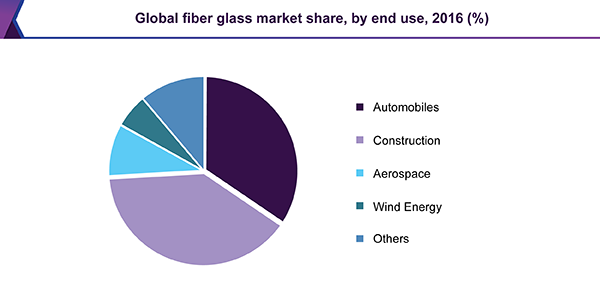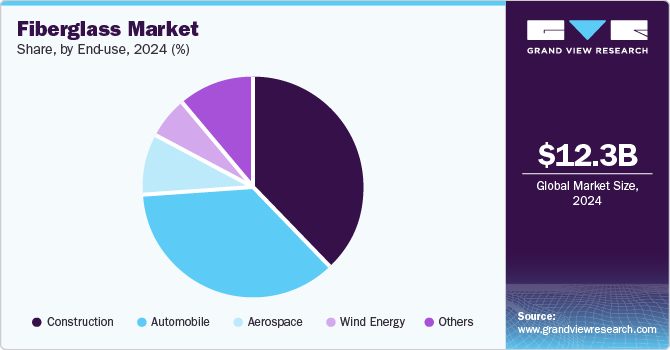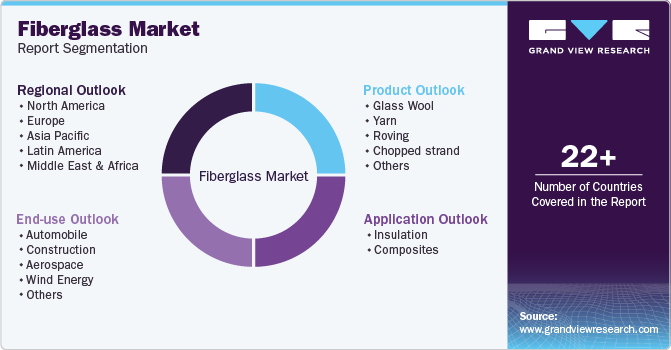
Fiberglass Market Size, Share & Trends Analysis Report By Application (Insulation, Liquid, Composites), By Type (Glass Wool, Yarn, Roving), By End Use (Automobiles, Construction), By Region, And Segment Forecasts, 2025 - 2030
- Report ID: GVR-2-68038-027-9
- Number of Report Pages: 100
- Format: PDF, Horizon Databook
- Historical Range: 2018 - 2023
- Forecast Period: 2025 - 2030
- Industry: Advanced Materials
Fiberglass Market Size & Trends
The global fiberglass market size was valued at USD 12.34 billion in 2024 and is projected to grow at a CAGR of 6.7% from 2025 to 2030. This growth is attributed to the increasing demand for lightweight and durable materials in the automotive and aerospace sectors, enhancing fuel efficiency and performance and driving market growth. In addition, investments in renewable energy, particularly for wind turbine blades, are boosting fiberglass usage. The construction industry's focus on energy-efficient buildings further propels demand, particularly in emerging economies. Furthermore, technological advancements and sustainability initiatives also play a significant role in this growth trajectory.

Fiberglass is a chemically stable, lightweight, and durable material extensively used in various industries, including marine, aerospace, electronics, automotive, plumbing, and storage solutions. The growing emphasis on reducing vehicle weight and enhancing fuel efficiency significantly boosts fiberglass demand. In addition, the rising need for insulation and composite materials in the automotive sector is expected to further stimulate market growth in the coming years.
Moreover, fiberglass also plays a crucial role in energy-efficient buildings by maintaining temperature and reducing energy costs. This trend aligns with increasing investments in sustainable construction. However, the environmental impact of fiberglass disposal poses challenges due to its inorganic fillers, which complicate recycling efforts and contribute to landfill waste. In the automotive industry, fiberglass is commonly used for components such as headliners and fenders.
Furthermore, stringent emission regulations worldwide encourage manufacturers to adopt lightweight materials like fiberglass to comply with standards such as CAFÉ. The construction sector remains a significant consumer of fiberglass for applications like mesh fabrics that prevent wall cracks and enhance waterproofing. Demand for fiberglass is expected to increase as renovation activities rise in North America and Europe. Moreover, the International Building Code now recognizes fiber-reinforced polymer (FRP) as a viable construction material for use above certain heights, further promoting fiberglass adoption in architecture and construction projects.
Product Type Insights
Glass wool led the market and accounted for the largest revenue share of 35.0% in 2024 attributed to its excellent thermal insulation properties, making it a preferred choice in the construction and HVAC industries. As energy efficiency becomes increasingly vital, the demand for insulation materials that reduce energy consumption in buildings is rising. In addition, the push for sustainable construction practices further enhances the appeal of glass wool, as it is recyclable and contributes to eco-friendly building standards. Furthermore, advancements in manufacturing processes are improving product quality and performance, supporting growth in this segment.
Chopped strand is expected to grow at the fastest CAGR of 7.2% over the forecast period, owing to their versatility and high mechanical strength, making them suitable for various applications across industries such as automotive, aerospace, and marine. Their lightweight nature helps enhance vehicle fuel efficiency while meeting stringent regulatory requirements. In addition, the growing trend towards sustainable materials also boosts demand for chopped strands, as they can replace traditional materials in composites. Furthermore, continuous innovations and technological advancements in production are expanding their applications, driving market growth significantly in sectors that require durable and efficient materials.
Application Insights
Composites dominated the market and accounted for the largest revenue share of 63.8% in 2024 attributed to the increasing demand for lightweight and high-performance materials across various industries, particularly automotive and aerospace. As manufacturers strive to enhance fuel efficiency and reduce emissions, composites offer an ideal solution due to their strength-to-weight ratio. Furthermore, the construction sector is increasingly adopting composites for their durability and resistance to environmental degradation. This trend is supported by stringent regulatory requirements encouraging using advanced materials, driving innovation and investment in composite technologies.
Insulations are expected to grow at a CAGR of 6.4% over the forecast period, owing to the rising focus on building energy efficiency. As construction activities expand globally, there is a heightened demand for effective thermal and electrical insulation materials. Fiberglass insulation helps maintain indoor temperatures, thereby reducing energy costs. In addition, the increasing emphasis on sustainable building practices further propels this demand, as fiberglass products are often recyclable and contribute to eco-friendly construction standards. Furthermore, ongoing renovations and remodeling projects replace traditional materials with fiberglass, enhancing structural stability and improving overall insulation performance.
End Use Insights
The construction segment held a dominant position in the market and accounted for the largest revenue share in 2024, driven by the increasing demand for energy-efficient and sustainable building materials. Fiberglass is widely used in insulation, roofing, and facade reinforcement applications due to its durability and excellent thermal properties. As urbanization accelerates, particularly in emerging economies, a heightened focus on infrastructure development further propels fiberglass demand. Furthermore, government regulations promoting sustainable construction practices contribute to the rising adoption of fiberglass in various building projects, enhancing its market value.

The automobile segment is expected to grow at a CAGR of 7.1% from 2025 to 2030. This growth is attributed to the industry's shift toward lightweight materials that improve fuel efficiency and reduce emissions. Stringent regulations like Corporate Average Fuel Economy (CAFÉ) standards prompt manufacturers to incorporate fiberglass into vehicle components like body panels and bumpers. In addition, the material's high strength-to-weight ratio allows for enhanced performance without compromising safety. Furthermore, the increasing focus on sustainability and the need for innovative materials in vehicle design are driving fiberglass adoption in automotive manufacturing, supporting overall market growth.
Regional Insights
The North America fiberglass market held a significant revenue share of 20.6% in 2024. This growth is driven by extensive infrastructure development and rising automotive sales. The region's focus on energy efficiency increases the demand for fiberglass insulation in buildings, enhancing overall energy performance. In addition, innovations in manufacturing processes are leading to improved product quality and applications across various sectors. Furthermore, as companies seek sustainable solutions, adopting fiberglass as a lightweight material for automotive components further supports market expansion in North America.
U.S. Fiberglass Market Trends
The growth of the fiberglass market in the U.S. is propelled by a strong demand from the construction and automotive industries. In addition, the emphasis on building energy-efficient structures has led to increased use of fiberglass insulation materials that contribute to reduced energy costs. Furthermore, stringent emission regulations encourage automakers to utilize lightweight fiberglass components to enhance vehicle efficiency. Moreover, continued investment in infrastructure projects drives demand for durable materials like fiberglass, solidifying its position in the U.S. market landscape.
Asia Pacific Fiberglass Market Trends
Asia Pacific fiberglass market dominated the global market and accounted for the largest revenue share of 48.6% in 2024 attributed to rapid industrialization and urbanization, particularly in countries such as China and India. The increasing demand for construction materials due to a burgeoning population and rising infrastructure projects significantly boosts fiberglass consumption. In addition, government initiatives promoting sustainable building practices enhance the appeal of fiberglass products. furthermore, the automotive sector's shift toward lightweight materials for improved fuel efficiency further propels market growth, alongside investments in renewable energy sources like wind power, where fiberglass is essential.

The fiberglass market in China dominated the Asia Pacific market and accounted for the largest revenue share in 2024, owing to its status as the largest producer and consumer globally. The country's aggressive infrastructure development and urbanization efforts are key drivers, resulting in heightened demand for construction materials. Furthermore, China's automotive industry is increasingly incorporating fiberglass to meet stringent emission regulations and enhance vehicle performance. Moreover, the government's focus on renewable energy initiatives, particularly in wind energy, also contributes to the rising need for fiberglass products, positioning China as a pivotal player in the global market.
Europe Fiberglass Market Trends
Europe fiberglass market is expected to grow at the fastest CAGR of 6.8% over the forecast period. This growth is attributed to its established automotive and aerospace industries. In addition, the construction sector's emphasis on energy-efficient buildings drives demand for insulation materials such as glass wool. Furthermore, the region's commitment to sustainability and innovation fosters advancements in fiberglass technology, further enhancing its applications across various industries.
The fiberglass market in Germany is expected to grow significantly over the forecast period, driven by a strong manufacturing base and a robust automotive sector that prioritizes lightweight materials. In addition, the country's focus on high-performance engineering and sustainability leads to increased use of fiberglass in-vehicle components and construction applications. Furthermore, Germany's commitment to renewable energy sources promotes the use of fiberglass in wind turbine production, aligning with national goals for energy transition.
Key Fiberglass Company Insights
Some of the key companies in the market include Owens Corning, Saint-Gobain, Nippon Electric Glass, and others. These companies leverage various strategies, including strategic collaborations, mergers and acquisitions, and new product launches, to enhance competitiveness. These strategies facilitate innovation, expand market reach, and optimize production efficiency while aligning with sustainability trends and consumer demands.
-
Saint-Gobain produces a wide range of fiberglass solutions, such as glass fiber mesh for insulation, wall coverings, and reinforcement grids for pavements. Beyond fiberglass, the company operates in various segments, including gypsum products, insulation solutions, and high-performance materials for the construction industry. With a strong commitment to sustainability, Saint-Gobain focuses on developing innovative materials that contribute to energy efficiency and environmental responsibility in building projects.
-
Jushi Group Co., Ltd. specializes in producing E-glass and S-glass fibers used in various applications, including construction, automotive, and aerospace industries. The company also offers fiberglass yarns, chopped strands, and woven fabrics that enhance the performance of composite materials. In addition to fiberglass, Jushi Group produces other advanced materials, such as resin systems and specialty composites, catering to diverse industrial needs while focusing on innovation and quality.
Key Fiberglass Companies:
The following are the leading companies in the fiberglass market. These companies collectively hold the largest market share and dictate industry trends.
- Owens Corning
- Saint-Gobain
- Nippon Electric Glass
- Jushi Group Co. Ltd.
- 3B-The Fiberglass Company
- PPG Industries
- Johns Manville
- Taishan Fiberglass, Inc.
- Chongqing Polycomp International Corp.
- Knauf Insulation
Recent Development
-
In April 2023, Saint-Gobain announced the acquisition of U.P. Twiga Fiberglass Ltd., a leader in India's glass wool insulation market. This strategic move aims to enhance Saint-Gobain's position in interior and façade solutions, addressing the increasing demand for energy-efficient and acoustic comfort solutions. U.P. Twiga functions two manufacturing services near Delhi and Mumbai and has used Saint-Gobain technology since 2005. The acquisition was expected to be finalized by the end of Q1 2023, aligning with Saint-Gobain’s commitment to sustainable construction practices.
Fiberglass Market Report Scope
|
Report Attribute |
Details |
|
Market size value in 2025 |
USD 13.12 billion |
|
Revenue forecast in 2030 |
USD 18.18 billion |
|
Growth rate |
CAGR of 6.7% from 2025 to 2030 |
|
Base year for estimation |
2024 |
|
Historical data |
2018 - 2023 |
|
Forecast period |
2025 - 2030 |
|
Quantitative units |
Volume in Kilotons, Revenue in USD million/billion, and CAGR from 2025 to 2030 |
|
Report coverage |
Revenue forecast, company ranking, competitive landscape, growth factors, and trends |
|
Segments covered |
Product type, application, end use, region |
|
Regional scope |
North America, Europe, Asia Pacific, Latin America, MEA |
|
Country scope |
U.S., Canada, Mexico, UK, Germany, France, India, China, South Korea, Brazil, Argentina, Saudi Arabia, and South Africa. |
|
Key companies profiled |
Owens Corning; Saint-Gobain; Nippon Electric Glass; Jushi Group Co. Ltd.; 3B-The Fiberglass Company; PPG Industries; Johns Manville; Taishan Fiberglass, Inc.; Chongqing Polycomp International Corp,; Knauf Insulation. |
|
Customization scope |
Free report customization (equivalent to 8 analyst working days) with purchase. Addition or alteration to country, regional & segment scope. |
|
Pricing and purchase options |
Avail customized purchase options to meet your exact research needs. Explore purchase options |
Global Fiberglass Market Report Segmentation
This report forecasts revenue growth at global, regional, and country levels and analyzes the latest industry trends in each sub-segment from 2018 to 2030. For this study, Grand View Research has segmented the global Fiberglass market report based on product type, application, end use, and region:

-
Product Type Outlook (Volume, Kilotons; Revenue, USD Million, 2018 - 2030)
-
Glass Wool
-
Yarn
-
Roving
-
Chopped strand
-
Others
-
-
Application Outlook (Volume, Kilotons; Revenue, USD Million, 2018 - 2030)
-
Insulation
-
Composites
-
-
End use Outlook (Volume, Kilotons; Revenue, USD Million, 2018 - 2030)
-
Automobile
-
Construction
-
Aerospace
-
Wind Energy
-
Others
-
-
Regional Outlook (Volume, Kilotons; Revenue, USD Million, 2018 - 2030)
-
North America
-
U.S.
-
Canada
-
Mexico
-
-
Europe
-
UK
-
Germany
-
France
-
-
Asia Pacific
-
India
-
Japan
-
China
-
South Korea
-
-
Latin America
-
Brazil
-
Argentina
-
-
Middle East and Africa (MEA)
-
Saudi Arabia
-
South Africa
-
-
We are committed towards customer satisfaction, and quality service.
"The quality of research they have done for us has been excellent."




